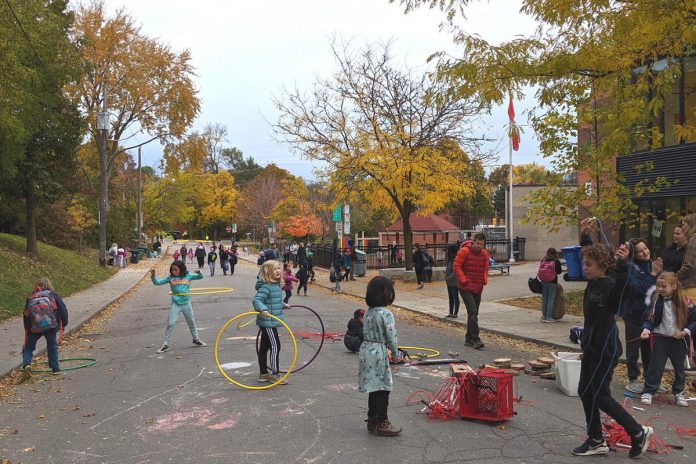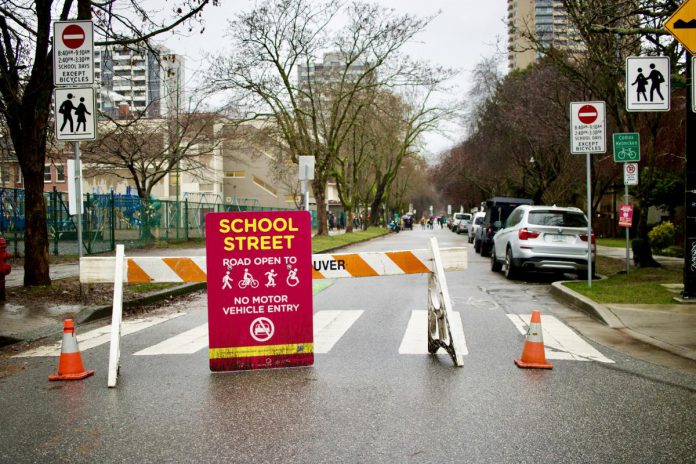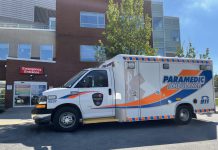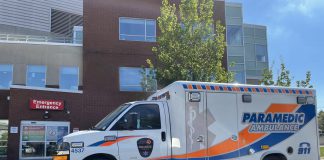
In an effort to promote physical activity among children, Peterborough-based Green Communities Canada and partners will receive $3 million from the Public Health Agency of Canada.
The money supports the National Active School Streets Initiative (School Streets), a nationwide collaboration between not-for-profit organizations, cities, research institutions, and others to create car-free zones in front of schools at the start and/or end of the school day.
The goal is to provide children with access to safe spaces that encourage physical activity.
“In communities across Canada, there has been an alarming decline in the number of children walking and cycling to and from school,” said Jared Kolb, Green Communities Canada’s interim executive director.
“Interventions like School Streets help to create safer and more walkable environments in front of schools, and in turn, support increased physical activity and well-being for children, their families, and the broader community.”
In addition to Green Communities Canada and non-profit organizations 8 80 Cities and Centre d’écologie urbaine, research institutions (Université de Montréal, University of British Columbia, Queen’s University, and Toronto Metropolitan University), and 16 community partners spanning six provinces (British Columbia, Alberta, Manitoba, Ontario, Quebec, and New Brunswick) are on board with the School Street initiative.
The School Streets program’s car-free spaces will be implemented in up to 30 communities, and range from a one-day pop-up event to a year-long intervention tailored to the local context of each participating community. The program will also include matching funding and community contributions, amounting to a $6 million investment in children’s physical activity through the next four years, the release noted.

“We know that many chronic diseases, including diabetes, cardiovascular disease and cancer, are often preventable by managing risk factors, including improving physical activity and fitness,” said Health Minister Mark Holland. “That is why we are proud to work with organizations like Green Communities Canada that are delivering invaluable community-based projects that will help improve the lives of their community members.”
The research institutions will conduct extensive evaluation at select implementation sites, collecting data on the number of participants, their socio-demographic backgrounds, and changes to children’s physical activity patterns, according to the release. Their research will shed light on understanding the impact of School Streets on communities, particularly low-income, racialized, and new-to-Canada populations.
“Collecting key evaluative data is essential to understanding the needs and priorities of communities that have been historically underrepresented,” said Dr. Katherine Frohlich, professor at the Université de Montréal and scientific director of the Institute of Population and Public Health at the Canadian Institutes of Health Research.
“Our evaluation activities will lead to the production of new scientific knowledge in population health intervention research, policy pathways, and recommendation reports to support the further delivery of School Streets programming across the country and potentially beyond.”
The Public Health Agency of Canada’s investment in School Streets will support the goal to increase children’s rates of physical activity and encourage communities across the country to rethink the way school communities are planned and built.
“The trip to and from school brings us together as neighbours, friends, and community,” said Joy Lachica, Peterborough’s deputy mayor and city councillor. “With the National Active School Streets Initiative, we can create an exciting strategy for the route, by offering safe, engaging and accessible pathways. Let’s build good health and relationships along the way.”
The School Streets program has been implemented across many cities in Canada, including Vancouver, Victoria, Winnipeg, Toronto, Kingston, Mississauga, and Montreal.
The 16-plus community partners will participate within one of three streams: as a “Level-Up” community, “Pilot” community, or “Aspiring” community.
The goal of Level-Up communities is to deepen the impact of their previous School Streets initiatives by delivering approximately two full-year interventions. Extensive evaluation will be done in Level-Up communities to analyze the impact of School Streets projects, particularly on underrepresented communities, partners noted.
Pilot communities will broaden the impact of School Streets in areas that have demonstrated some existing readiness or previous experience.
Aspiring communities will build momentum for School Streets initiatives in areas that have no previous implementation experience. Communities with demonstrated readiness will deliver short pop-up interventions spanning approximately one-week.
The Public Health Agency of Canada will be funding School Streets through the Healthy Canadians and Communities Fund (HCCF). This year, the fund released $9 million to support seven physical activity projects across Canada.
Through the HCCF, the Public Health Agency of Canada supports projects that address physical inactivity to help people in Canada lower their risk of chronic disease and improve their overall physical and mental health, noted the Green Communities website. The program supports interventions that focus on people who face health inequalities and are at greater risk of developing chronic disease.



























